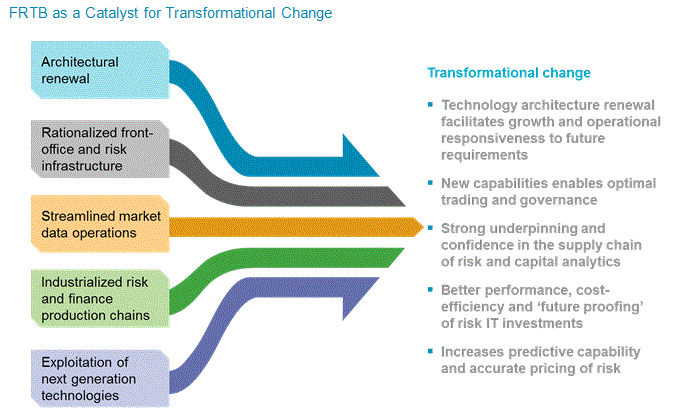FRTB and the Upcoming Renaissance in Market Risk Management, Part 2: Transformation Opportunities and Smarter IT Implementations
Abstract
Celent has released a new report titled FRTB and the Upcoming Renaissance in Market Risk Management, Part 2: Transformation Opportunities and Smarter IT Implementations. The report was written by Cubillas Ding, a Research Director with Celent’s Securities & Investments practice.

With Fundamental Review of the Trading Book (FRTB) projects moving from initial quantitative exercises into actual design and implementation phases, having a cohesive approach to plan both strategic and tactical elements upfront when connecting the various stakeholders in front office, risk, IT, and market data operations is critical.
During implementation stages and for “build vs buy” decisions, firms must formulate implementation plans cohesively across various stages, considering: FRTB ambitions and future vision; solution build-buy options against strategic gaps; and ease of implementation, time-to-benefit, and total cost of ownership tradeoffs; as well as operational and change management implications.
Even though FRTB represents mandatory regulatory spending, forward-looking institutions see it as a one-off opportunity for front office, risk, finance, and market data operations stakeholders to collaborate to deliver something that is meaningful to the business. Firms with FRTB programmes that are targeting ambitions beyond standard compliance must adopt a disciplined approach to business case development for various parts of their investment, based on estimated effort, cost, and timelines provided in RFP responses, and proactively monitor progress against the business case targets, constraints, and assumptions.
Looking forward, FRTB is setting in motion a trajectory that incentivizes firms to move towards stronger business and functional risk management capabilities built on sound data and analytical supply chains and “front-to-back-aligned” information delivery, with shareable service and process components enabling optimal trading, risk-aligned pricing, and governance. At the same time, through the clever exploitation of next-generation technologies, firms can achieve better performance, cost-efficiency, and “future-proofing” of risk IT investments.

“Celent believes that we are standing at the dawn of a new renaissance in market risk management, and the banking industry is certainly ripe for an overhaul,” says Ding.
“Critical FRTB implementation activities executed in the coming years will determine a firm’s prospects as we head towards 2020 and beyond. However, the right design and smart execution of programme management activities, guided by sound implementation and build-buy decisions, are paramount in order to achieve success on this complex journey,” he adds.

